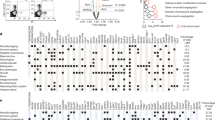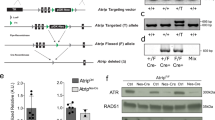Abstract
Patients with the human disorder ataxia-telangiectasia (A-T; refs 1,2) and Atm-deficient mice3–5 have a pleiotropic phenotype that includes infertility. Here we demonstrate that male gametogenesis is severely disrupted in Atm-deficient mice in the earliest stages of meiotic prophase I, resulting in apoptotic degeneration. Atm is required for proper assembly of Rad51 onto the chromosomal axial elements during meiosis. In addition, p53, p21 and Bax are elevated in testes from Atm-deficient mice. To determine whether these elevated protein levels are important factors in the meiotic disruption of Atm-deficient mice, we analysed the meiotic phenotype of Atm/p53 or Atm/p21 double mutants. In these double mutants, meiosis progressed to later stages but was only partly rescued. Assembly of Rad51 foci on axial elements remained defective, and gametogenesis proceeded only to pachytene of prophase I. Previous results demonstrated that mice homozygous for a null mutation in Rad51 (ref. 6) display an early embryonic lethal phenotype that can be partly rescued by removing p53 and/or p21. Because Atm-deficient mice are viable but completely infertile, our studies suggest that the Rad51 assembly defects and elevated levels of p53, p21 and Bax represent tissue-specific responses to the absence of Atm.
This is a preview of subscription content, access via your institution
Access options
Subscribe to this journal
Receive 12 print issues and online access
$209.00 per year
only $17.42 per issue
Buy this article
- Purchase on Springer Link
- Instant access to full article PDF
Prices may be subject to local taxes which are calculated during checkout
Similar content being viewed by others
References
Boder, E. Ataxia-telangiectasia: some historic, clinical and pathologic observations. Birth Defects. 11, 255–270 (1975).
Sedgewick, R. & Boder, E., Ataxia-telangiectasia. in Handbook of Clinical Neurology(eds Vinken, P., Bruyn, G. & Klawans, H.) 347–423 (Elsevier Scientific, New York, 1991).
Barlow, C et al. Atm-deficient mice: a paradigm of ataxia telangiectasia. Cell 86, 159–171 (1996).
Xu, Y. et al. Targeted disruption of ATM leads to growth retardation, chromosomal fragmentation during meiosis, immune defects, and thymic lymphoma. Genes Dev. 10, 2411–2422 (1996).
Elson, A. et al. Pleiotropic defects in ataxia-telangiectasia protein-deficient mice. Proc. Atal. Acad. Sci. USA. 93, 13084–13089 (1996).
Lim, D. S. & Hasty, P. A mutation in mouse rac/57 results in an early embryonic lethal that is suppressed by a mutation in p53. Mol. Cell. Biol. 16, 7133–7143 (1996).
Moens, P.B. et al. Rad51 immunocytology in rat and mouse spermatocytes and oocytes. Chromosoma(in the press).
Baskaran, R. et al. Ataxia telangiectasia mutant protein activates c-Abl tyrosine kinase in response to ionizing radiation. Nature 387, 516–519 (1997).
EI-Deiry, W.S. et al. WAF1/CIP1 is induced in p53-mediated G1 arrest and apoptosis. Cancer Res. 54, 1169–1174 (1994).
Miyashita, T. & Reed, J.C. Tumor suppressor p53 is a direct transcriptional activator of the human bax gene. cell 80, 293–299 (1995).
Jacks, T. et al. Tumor spectrum analysis in p53-mutant mice. Curr. Biol. 4, 1–7 (1994).
Deng, C., Zhang, P., Harper, J.W., Elledge, SJ. & Leder, P. Mice lacking p21cIp1/WAF1 undergo normal development, but are defective in G1 checkpoint control. Cell 82, 675–684 (1995).
Moens, P.B. Histones H1 and H4 of surface-spread meiotic chromosomes. Chromosoma 104, 169–74 (1995).
Scully, R. et al. Association of BRCA1 with Rad51 in mitotic and meiotic cells. Cell 88, 265–275 (1997).
Sharan, S.K. et al. Embryonic lethality and radiation hypersensitivity mediated by Rad51 in mice lacking Brca2. Nature 386, 804–810 (1997).
Hakem, R., de la Pompa, J. L., Elia, A., Potter, J. & Mak, T.W. Partial rescue of Brcaf5–6early embryonic lethality byp53orp27 null mutation. Nature Genet. 16, 298–302 (1997).
Ludwig, T., Chapman, D.L., Papaioannou, V.E. & Efstratiadis, A. A Targeted mutations of breast cancer susceptibility gene homologs in mice: lethal phenotypes of Brcal, Brca2, Brca1/Brca2, Brca1/p53, and Brca2/p53 nullizygous embryos. Genes Dev. 11, 1226–1241 (1997).
Ko, L.J. & Prives, C. p53: puzzle and paradigm. Genes Dev. 10 1054–1072 (1996).
Levine, A.J. p53, the cellular gatekeeper for growth and division. Cell 88, 323–331 (1997).
Luna, L.G. Methods and Color Atlas of Special Stains and Tissue(American Histolabs, Gaithersburg, Maryland, 1992).
Dresser, M.E. & Moses, M.J. Silver staining of synaptonemal complexes in surface spreads for light and electron microscopy. Exp. Cell. Res. 121, 416–419 (1979).
Dobson, M.J., Pearlman, R.E., Karaiskakis, A., Spyropoulos, B. & Moens, P.B. Synaptonemal complex proteins: occurrence, epitope mapping and chromosome disjunction. j.Cell Sci. 107, 2749–2760 (1994).
Harlow, E. & Lane, D. Antibodies: A Laboratory Manual(Cold Spring Harbor Laboratory, Cold Spring Harbor, New York, 1988).
Author information
Authors and Affiliations
Corresponding author
Rights and permissions
About this article
Cite this article
Barlow, C., Liyanage, M., Moens, P. et al. Partial rescue of the prophase I defects of Atm-deficient mice by p53 and p21 null alleles. Nat Genet 17, 462–466 (1997). https://doi.org/10.1038/ng1297-462
Received:
Accepted:
Issue Date:
DOI: https://doi.org/10.1038/ng1297-462
This article is cited by
-
ATM specifically mediates repair of double-strand breaks with blocked DNA ends
Nature Communications (2014)
-
A role for c-Abl in cell senescence and spontaneous immortalization
AGE (2013)
-
Programmed cell death may act as a surveillance mechanism to safeguard male gametophyte development in Arabidopsis
Protein & Cell (2011)
-
Chromosomes, recombination and proteins at meiosis – A tribute to Peter Moens (1931–2008)
Chromosome Research (2008)
-
ATM and ataxia telangiectasia
EMBO reports (2004)



